Paul Gilster's Blog, page 221
July 31, 2013
Brown Dwarf Planets: Catching Up with Recent Work
Red dwarf stars of the sort we discussed yesterday are all over the galaxy, comprising perhaps as much as 80 percent of the stellar population. Brown dwarfs are different. Data from the Wide-Field Infrared Survey Explorer mission (WISE) indicate that these ‘failed’ stars — brown dwarfs are too small to sustain hydrogen fusion — exist in smaller than expected numbers, at least in our stellar neighborhood. WISE could find but one brown dwarf for every six stars (see Brown Dwarfs Sparser than Expected for more on the WISE findings).
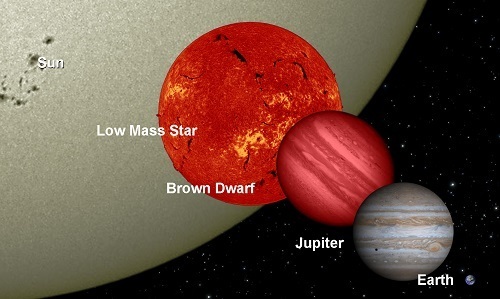
Image: Brown dwarfs in relation to the Sun and planets. Credit: NASA/WISE mission.
As we learn more about the brown dwarf population, we can keep in mind the tantalizing fact that several of these objects have been found with disks of material around them, leading to the speculation that they can form planets in the same way that normal stars can. It’s true that several objects have already been found associated with brown dwarfs, but they tend to be large enough in relation to the dwarf that they could almost be considered part of binary systems. Add to that the fact that dwarfs like 2MASS 1207-3932 are widely separated from their companion (45 AU in the case of 2MASS 1207-3932 and 15 AU for the dwarf 2MASS 0441-2301).
Whatever we call the objects around these two brown dwarfs, they seem unlikely to have formed out of protoplanetary disk material, says a draft version of a new paper on a brown dwarf planetary discovery by the gravitational microlensing team called OGLE (Optical Gravitational Lensing Experiment). The new planet — OGLE-2012-BLG-0358Lb — is different. It’s lower in mass compared to its brown dwarf primary than the other brown dwarf planetary finds, about 1.9 Jupiter masses as compared with the brown dwarf’s mass of 0.022 that of the Sun, making the dwarf about ten times larger than the companion. The presumed planet is also comparatively close in at 0.87 AU.
The discovery paper suggests that these differences point to the companion forming, like a conventional planet, from the protoplanetary disk around the brown dwarf, although it hedges its bets on just how that formation occurred:
Surveys for disks around young BD have found some systems with inferred disk masses up to and even slightly exceeding ∼ MJ…, although these are relatively rare and the inferred masses are subject to considerably uncertainty. Such massive disks are likely to be near the limit of stability…, arguing for a gravitational instability formation scenario rather than core accretion. On the other hand, the relatively close separation may pose a challenge for gravitational instability. Clearly, additional theoretical work is needed to explore the viability of planet formation in BD protoplanetary disks, either by the gravitational instability or core accretion mechanism. For this, it is essential to find more binaries with BD hosts in wide ranges of mass ratios and separations.
Microlensing seems well adapted to this task with its ability to detect planets around extremely faint, low mass stars. The light of a background star is here bent around the gravitational well caused by the gravity of an intervening object, in this case a brown dwarf. Analysis of the light curve brings out the existence of the accompanying planet. Teams using these methods are homing in on other brown dwarf systems looking to learn more about planet formation, work that will tell us how planets form here and how common we can expect them to be.
The paper is Han et al., “Microlensing Discovery of a Tight, Low Mass-Ratio Planetary-Mass Object Around an Old, Field Brown Dwarf,” submitted to The Astrophysical Journal (abstract).
Let me also point you to an interesting paper by Matthew Route and Alex Wolszczan (both with Penn State affiliations). It’s “The Arecibo Detection of the Coolest Radio-Flaring Brown Dwarf,” in Astrophysical Journal Letters Vol. 747, No. 2, L22 (abstract). These researchers are reporting on the detection of naturally emitted radio waves and the discovery of the magnetic field strength of the coolest planet-sized object outside our own Solar System. The radio waves are not unexpected — Jupiter and Saturn also produce radio waves via what’s known as Electron Cyclotron Maser Instability (ECMI) — but this discovery involves emissions from a brown dwarf.
Matthew Route has a fine explanation of this work online. The brown dwarf is 2MASS J10475385+212434, a T6 dwarf with a spectrum showing water, methane and hydrogen, and a temperature of about 900 K. The magnetic field strength is measured at 3000 times that of the Earth, and 100 times the strength of Jupiter’s magnetic field at its poles.
Ultimately we’d like to measure natural radio emissions not just from brown dwarfs but from exoplanets, a quest explained by Route:
1. They give us insight as to the strength of magnetic fields on other planets, which is something completely new and unstudied for exoplanets.
2. They tell us something about the internal processes near the cores of the exoplanets.
3. Exoplanet rotation rates could be determined this way.
4. The presence of moons around various exoplanets could be inferred from how they interact with and cause emission from the exoplanet’s magnetic field.
5. The magnetic fields that give rise to them are probably necessary for life.
That last item catches the eye, of course, and it’s a nod to the fact that a strong magnetic field helps to protect life on Earth from bombardment by charged particles. Two other things come to mind here, the first being the work of Jonathan Nichols (University of Leicester) on detecting auroral emissions from exoplanets and the possibility of using instruments like the Low Frequency Array for such studies. The other item is Heikki Vanhamaki’s work at the Finnish Meteorological Institute in Helsinki. Vanhamaki has suggested using natural radio emissions to detect solitary ‘rogue’ planets wandering between the stars.
The brown dwarf findings by by Route and Wolszczan are an impressive step in the direction of tuning these methods for exoplanets around brown dwarfs and elsewhere. I’m roaming widely on the brown dwarf topic this morning, and that should be an indicator not only of my fascination with these objects but with the fact that they and their potential planets are an increasingly significant area of research.






July 30, 2013
Climate Models for Red Dwarf Planets
Although it’s hard for me to believe it, there was a time nine years ago, not long after I began writing these posts, when a daily scramble for topics was fairly common. How the world has changed. These days, between the huge increase in online discussion of interstellar flight and the burgeoning exoplanet scene, the problem becomes to keep from falling too far behind. I’m already a couple of weeks out on interesting work from the University of Washington on one of my favorite topics, red dwarfs and the possibilities for life there. It’s time to catch up.
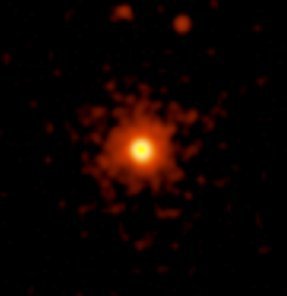
What Aomawa Shields has been examining in her recent work is climate in the extreme, the kind of ‘snowball Earth’ event that, in several periods 600 million years ago and earlier, may have covered the planet in ice from pole to pole. Shields’ new paper in Astrobiology goes at the question of climate extremes on planets around M-dwarfs, where conditions are markedly different than around stars like the Sun. It turns out that M-dwarf planets, even when they receive the same amount of light, may be warmer than their counterparts orbiting larger, hotter stars.
The reason: While hotter stars emit more visible and ultraviolet light, cooler stars are rich in infrared and near-infrared wavelengths. Ice and snow absorb longer wavelength near-infrared light more efficiently than visible light, which tends to be strongly reflected. In the red dwarf scenario, then, the absorption of light by ices and snows helps to warm the planet, a trend that can be compounded by atmospheric greenhouse gases that also absorb near-infrared light.
Image: Proxima Centauri, the nearest star to our own, and an example of a red dwarf with frequent flare activity. New work from the University of Washington suggests that M-dwarf planets are more likely to avoid ‘snowball’ events when the planet becomes completely covered with ice. No planets have yet been discovered around Proxima Centauri, but the hunt continues. Credit: NASA/CXC/SAO.
Whereas hotter stars may have their visible and ultraviolet light reflected by ices and snows on the surface (‘ice-albedo feedback’ is the term), the M-dwarf stays warmer at the same level of incoming light. M-dwarf planets are more likely to avoid the kind of snowball states that terrestrial worlds around hotter stars fall into. From the paper (citations removed for brevity):
Because of the spectral dependence of ice albedo, the ice-albedo feedback mechanism is sensitive to the wavelength of light coming from the host star. On M-dwarf planets, a significant amount of radiation emitted by the host star is absorbed by atmospheric gases such as CO2 and water vapor, which absorb strongly in the near IR… However, a disproportionate amount of the longer-wavelength radiation that does reach the surface will be absorbed by, rather than reflected from, icy or snowy surfaces on these planets.
The effects are striking, because conditions for runaway icing don’t occur:
This will reduce the difference between ice and ocean surface albedo. Episodes of low-latitude glaciation, termed “Snowball Earth” events… may be less likely to occur on M-dwarf planets as a result of the lower-albedo ice on their surfaces, as entrance and exit into such a snowball state has been shown to be sensitive to ocean-ice albedo contrast…
Snowball states don’t preclude life, of course — Earth itself is proof of that — but Shields argues that astronomers will want to prioritize their searches for planets less vulnerable to them (see this University of Washington news release for more). That seems an unnecessary leap given that snowball events can be a catalyst for emerging life, as the paper goes on to discuss:
The Neoproterozoic Snowball Earth episodes of 750 to 635 million years ago have been linked to the emergence of multicellular life on Earth due to enhancement of the flux of dissolved phosphates into the ocean, which would have caused increased primary productivity and organic carbon burial and led to the rise of oxygen in the ocean and atmosphere… Planets less likely to experience such global-scale glaciations may therefore be dependent on alternate pathways to serve as catalysts for biological evolution. The M-dwarf planet in our simulations also exhibited more stable lower-latitude ice lines than the G- or F-dwarf planets; this may be due to the lower-albedo ice formed on its surface. A more stable low-latitude ice line on M-dwarf planets may be possible as the result of a lower albedo contrast between bare sea ice and snow-covered ice…
Shields and team used three-dimensional atmospheric circulation models to simulate planets covered by ocean, land and water ice under different conditions of incident radiation from a variety of star types. The effect of icy surfaces absorbing light works along with greenhouse gas absorption to reduce the frequency of snowball events. The effect becomes less of a factor as we move to the outer edge of the habitable zone, where greenhouse gases like atmospheric CO2 reach high levels and ice-albedo feedback plays a much smaller role.
The paper is Shields et al., “The Effect of Host Star Spectral Energy Distribution and Ice-Albedo Feedback on the Climate of Extrasolar Planets,” published online by Astrobiology July 15, 2013 (full text).






July 29, 2013
Remembering The Listeners
Back in the 1970s I ran across an essay by James Gunn called “Where Do They Get Those Crazy Ideas,” which was all about how science fiction worked and where its writers sought inspiration. I had long admired Gunn, a college professor who was developing a body of critical work on science fiction even as he continued to publish taut, interesting stories like those I had seen collected in Station in Space (1958) and The Joy Makers (1961). A story first published in Galaxy called “The Cave of Night” had particularly haunted me and led me to seek out more of his work.
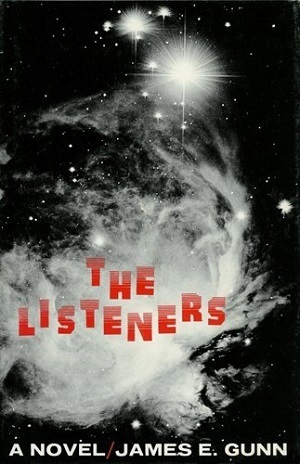
On the spur of the moment, I wrote Gunn a brief note of appreciation for the essay on writing, not thinking I would hear back from him, but sure enough a letter swiftly appeared inviting me to come to Kansas that summer, where he would be leading a science fiction workshop. That was a trip I wasn’t able to schedule, but I kept an eye on Gunn’s writing and finally, some years after its publication, sat down to read The Listeners, a 1972 novel that was actually made up of previously published stories adapted into a book using various transitional devices.
I believe this practice is known as a ‘fixup’ in the science fiction community — the field is rife with examples from Clifford Simak’s City to Keith Roberts’ Pavane — but here the effect is a bit like Dos Passos, or John Brunner’s Stand on Zanzibar, as the linear narrative is peppered with news reports and frequent quotes from poets and astrophysicists alike. At center is the detection of a message from an extraterrestrial civilization and its effects on the people who find the signal, as well as the society that has to integrate ET into its worldview. Gunn was inspired by Walter Sullivan’s 1966 SETI book We Are Not Alone, and in fact dedicates the volume to Sullivan, along with Carl Sagan and all those working in the SETI field.
Sagan apparently told Gunn that The Listeners had been one of the inspirations for his novel Contact, which would not be surprising given the plot premise. The novel anticipates so many of the ideas we’ve kicked around here for the last nine years that I’m surprised it hasn’t come into our discussions more often. If a message is received, do we respond to it? Would human reaction to such a signal be positive or fearful? In the case of The Listeners, we also deal with the question of motivations, for Gunn’s characters have a visual diagram sent by the aliens to work with and its contents are ambiguous, showing a humanoid creature along with the suns of a planet around the multiple star system Capella.
The system is a long way off, a 90-year round trip by radio, and the final decision to reply is motivated by a fresh decoding of what the message contains: The sending civilization is about to be destroyed. At least that’s the belief, based on a single message that was apparently sent to initiate an exchange of information, the bulk of which would take place through a colossal return message that could be expected in another 90 years, assuming humanity made the choice to answer. As you might expect, surprises are still in store, and I won’t give away what they are for those who haven’t yet read the book. Gunn’s denouement, suffice it to say, is not Sagan’s, though it does point to a future where interstellar communication will be common.
One of the pleasures of The Listeners is the interspersed quotations, from which this one, by SETI pioneer Philip Morrison, is particularly apropos given our recent discussion of galactic libraries:
Advanced societies throughout the galaxy probably are in contact with one another, such contact being one of their chief interests. They have already probed the life histories of the stars and other of nature’s secrets.The only novelty left would be to delve into the experience of others. What are the novels? What are the art histories? What are the anthropological problems of those distant stars? That is the kind of material that these remote philosophers have been chewing over for a long time…
Morrison was thinking that back in 1961, just a couple of years after the groundbreaking paper he wrote with Giuseppe Cocconi, “Searching for Interstellar Communications,” appeared in Nature (the paper is available online). Gunn has been thinking about similar issues since his first science fiction began appearing in the late 1940s (his first tale was “Communications,” which appeared in the September 1949 Startling Stories. I just missed noting his 90th birthday (July 12) but am reminded by that event that a new novel, called Transcendental, is soon to be published, a heartening reminder of the continuing imaginative gift of an author whose The Listeners rewards re-reading.






July 26, 2013
The Milky Way’s Library
This is as strange a maze as e’er men trod,
And there is in this business more than nature
Was ever conduct of.
That’s Alonso in Shakespeare’s late masterpiece The Tempest, a king of Naples who finds himself on a remote island where Prospero weaves his magical powers. It’s an apt passage for Timothy Ferris to quote in his chapter “The Central Nervous System of the Milky Way,” a part of the 1992 collection The Mind’s Sky that was the basis of yesterday’s post. For in an unusual conclusion to the essay, Ferris wonders whether the real purpose of a galactic network (and hence an ultimate goal of SETI) isn’t passing along not only our science but our broader culture to other civilizations. “Who knows what importance our existence, or some shard of our thought, might have to a scholar or artist — whether biological or artificial in origin — in a remote galaxy in some far-future time?”
It’s a pleasing thought for a species used to feeling dwarfed by the universe, and it would apply to all intelligent species whose work might find an enthusiastic reception elsewhere. But I return to Ferris because his essay looks out on a vista that is conceivably not just interstellar but intergalactic. A long-term, evolving network, growing by virtue of the very traffic it handles, may come to approximate the galactic nervous system of the title. Reaching another galaxy with a series of self-reproducing probes would obviously take eons, a project well beyond the intent of a biological species perhaps, but not out of the question for an automated, growing mind. Would such a vast communicating web ever run out of topics to consider? From the essay:
“…on no level, even that of a pangalactic intelligence, could mystery ever be wholly banished. The observable universe — meaning that part of the cosmos within which light signals can at any given epoch be detected — is eternally smaller than the totality of the universe. Even if the entire Virgo Supercluster is embroiled in thought, a million galaxies buzzing with lanky synapses that take tens of millions of years to connect, that vast intelligence will always have more to learn, and forever have room to wonder.

Image: The wreck of the Sea Venture off the Bermudas in 1609, an event thought to be an inspiration for Shakespeare’s The Tempest. Will works of human imagination one day flow through a galactic network, preserving our art, science and philosophy beyond the lifetime of our species? Painting by W. H. Harrington. Credit: Bermuda National Trust and Bermuda Maritime Museum.
The Problem of the Probe
But back to a much simpler network, the one formed by early self-reproducing probes as they expand outward from the home world of their builders. One objection to self-reproduction is that the probes in question eventually mutate, become virus-like in their spread and run essentially out of control of their makers, with results we cannot anticipate (Carl Sagan raised this issue back in the 1980s, speaking about strategies for colonizing the galaxy). Ferris thinks that intelligent builders will understand the problem from the start. They’ll put the network together under the same principles that telecommunication companies today work under, expanding infrastructure only at a pace demanded by traffic, with the network in charge of replication rates.
That very significant concern aside, the advantages of running a galactic network are manifest. For one thing, civilizations anxious to preserve their legacy will be committing their output to a growing library that will outlast all civilizations (just as, to use a pedestrian comparison, I take a certain comfort in knowing that every word I type on this keyboard is automatically backed up on multiple servers in the cloud). A second virtue is the network’s ability to shield participating civilizations. We’ve had the METI argument before and will have it again. Messaging extraterrestrial civilizations opens the sender up to the uncertainty of not knowing what forms of intelligence receive the signal, nor what the result of the attempted contact may be.
The galactic network, if it is designed with clever parameters, gets around this by duplicating its data throughout the entire system, working with a time span that grows as the constituent builder probes continue to reproduce and spread outwards. Information about the participant worlds can be, in Ferris’ view, filtered in whatever way the local civilization chooses, allowing a culture to share itself with a carefully modulated dose of privacy. Here the Internet metaphor that runs through Ferris’ thinking betrays him, as we all ponder how hackers move through our existing worldwide networks even as security specialists try to find the holes that let them in.
Imagine that we receive an invitation to join such a network on some future day. Do we accept it? Here I’m thinking of David Brin’s recent novel Existence, where the question of whether interstellar visitors are telling the truth — and speculations about why they might not — form a part of the developing conversation about the consequences of contact. What happens if our expansion into the cosmos creates encounters with not one but several civilizations, and what if they each give us a different narrative about what we as a culture need to do next?
Stored Data and Communication Times
No, I can see many reasons for being skeptical of the emissaries of a purported galactic network. On the other hand, there seem to be many reasons to think of building one ourselves, once we have such capabilities. Network terminals established at locations between known civilizations would make information exchange a bit easier as we and they tapped closer sources of data. And I like the spirit with which Ferris approaches this possibility:
One is communicating, of course, not with living beings but with a computer, but the computer is rich with information deposited there by living beings, and one should not underestimate the value of such an arrangement. I can enjoy a play by the late Samuel Beckett without fretting overmuch about the fact that I cannot correspond with Beckett, and if I read a book or watch a movie or run a computer program I am in a sense communicating with the authors of those creations, regardless of whether they are dead or alive.
In that sense, of course, it’s hard to see how any great author is truly dead. As long as the ideas are being transmitted and received, the unique perceptions of that personality are still available to us. Imagine the riches of a network created billions of years in the past, laden with the science and poetry of countless cultures, many of whom are doubtless long gone. It’s a heartening thought that such a thing could exist if civilizations live long enough to launch this kind of self-reproducing enterprise into the heavens. We saw yesterday that Geoff Marcy’s work will now extend to a search for extraneous optical transmissions from extraterrestrials at work. If successful, that search would tell us that intelligent life is out there, but a single flash in the night without the keys to the library — assuming there is one — will long remain an enigma.
The Sagan paper I refer to above was written with William Newman. It’s “The Solipsist Approach to Extraterrestrial Intelligence,” Quarterly Journal of the Royal Astronomical Society, Vol. 24, No. 113 (1983). Its point is that self-reproducing probes of the sort Ferris describes will never be built because they constitute a threat to their builders as well as other sentient species that encounter them. Fred Saberhagen’s ‘Berserker’ stories invariably come to mind.






July 25, 2013
Finding the Galactic Internet
Greg Egan, a jewel in Australia’s science fiction crown, writes in his 1997 novel Diaspora about a mind-bending far future scenario for interstellar travel. The human race has split into those still in biological bodies, those embedded in humanoid robots, and those who choose to live as software running on central computers. I won’t get into the rich details of the novel this morning, but suffice it to say that the diaspora portrayed here involves a thousand clones of a future Earth community sent to explore nearby stars. Different digitized copies of the same characters spin out their own story lines over a background that spans hundreds of light years.
This is one way to get to the stars, reminiscent of Robert Freitas’ nanotech probes that house thousands of human intelligences in spacecraft no larger than needles. It’s a reminder that highly advanced future cultures may have means at their disposal for star travel even if we find no way of getting up to more than a small percentage of the speed of light. It’s also a memo to SETI theorists about what we might look for as we ponder the shape of extraterrestrial civilizations. If biological life is gradually replaced in favor of software and AI, what signatures will we find?

Image: A classic spiral, the Whirlpool Galaxy (M51) is 30 million light years distant and 60 thousand light years across. What sort of communications network might link civilizations here? Credit: N. Scoville (Caltech), T. Rector (U. Alaska, NOAO) et al., Hubble Heritage Team, NASA.
Egan’s work came to mind as I read this Washington Post story about Geoff Marcy’s recent grant from the Templeton Foundation. The grant is one we’ve discussed before (see Finding ET in the Data), and it’s noteworthy that Marcy’s hunt for Dyson spheres is paralleled by grants to Jason Wright (Pennsylvania State) and colleagues Steinn Sigurðsson and Matthew Povich, who will be using data from the Wide-Field Infrared Explorer satellite (WISE), as well as Lucianne Walkowicz (Princeton University), whose team will be looking through Kepler data for unusual light curves that might flag artificial constructions of enormous size.
I’ll naturally track these projects with great interest. But for today, I want to focus on the rest of Marcy’s search. For while Dyson spheres invariably seem to draw the most attention, only a fraction of the $200,000 Templeton grant will be devoted to their discovery. While some of that money will fund the work of a grad student developing code to search the Kepler data for unusual signatures, the rest buys Marcy time at the Keck Observatory at Mauna Kea, where the game shifts to optical SETI as Marcy tries to spot the laser signaling of an interstellar network.
Enter the Galactic Internet
Like Robert Freitas, Timothy Ferris has speculated about self-reproducing probes that could be sent in small packages to neighboring star systems. Here the idea is that the probe mines local resources, perhaps in an asteroid belt around the target star, and builds an observatory that can send information back to Earth. Over the course of time, the probe reproduces and sends a clone of itself still further out. Ferris’ own thoughts on this go back for more than three decades — see his 1992 title The Mind’s Sky: Human Intelligence in a Cosmic Context for more — and include the emergence of a potentially galaxy-spanning network. The probes become communications stations that constantly monitor other such stations, transmitting and receiving data. Each station becomes a library as galactic information is stored and forwarded:
The interstellar network functions independently of any one world. It has a master program, akin to a set of genetic instructions, originally composed by intelligent biological beings or by another computer. This program gives it its charter — to handle traffic efficiently, to store and organize a copy of everything it conveys… to keep expanding the network as the traffic requires, to search for new communicative worlds, and to keep querying worlds that have gone off line to see whether someone may still be there. How, exactly, it goes about doing these things is its own affair; once set in motion the network has a life of its own.
A galactic network begins with the realization that sending short, conversational messages to other systems is not the way to proceed. Instead, messages will be long and content-laden simply because of the amount of time it takes to communicate. We don’t know how long civilizations last, but Ferris notes that even if a culture managed to stay in communications mode for ten million years, that would still represent no more than one tenth of one percent of the age of the galaxy. And that would mean that only one in 1000 of all civilizations that have inhabited the Milky Way is still in existence, formidable odds for those who want to communicate with distant cultures.
Although Ferris has been thinking about interstellar networking since 1975, the emergence of the Internet spurred the notion of what he calls a ‘galactic central nervous system.’ Node connects to node and, potentially, to the nodes of other discovered civilizations, with an efficient network flow that means knowledge of other cultures spreads gradually and without the need for point-to-point contact between each of the discovered civilizations. Each node keeps and distributes the data it collects. In a 1999 essay called “Interstellar Spaceflight: Can We Travel to Other Stars?” Ferris mused on the consequences of such a network for what we see around us:
If there were any truth in this fancy, what would our galaxy look like? Well, we would find that interstellar voyages by starships of the Enterprise class would be rare, because most intelligent beings would prefer to explore the galaxy and to plumb its long history through the more efficient method of cruising the Net. When interstellar travel did occur, it would usually take the form of small, inconspicuous probes, designed to expand the network, quietly conduct research and seed infertile planets. Radio traffic on the Net would be difficult for technologically emerging worlds to intercept, because nearly all of it would be locked into high-bandwidth, pencil-thin beams linking established planets with automated nodes. Our hopes for SETI would rest principally on the extent to which the Net bothers to maintain omnidirectional broadcast antennae, which are economically draining but could from time to time bring in a fresh, naive species – perhaps even one way out here beyond the Milky Way’s Sagittarius Arm. The galaxy would look quiet and serene, although in fact it would be alive with thought.
In short, it would look just as it does.
Can such a network, one that maintains ‘omnidirectional broadcast antennae,’ survive the analysis of work like Jim and Greg Benford’s on economically viable beacons? A more likely scenario seems to be what Marcy is suggesting, that what we might detect is an errant beam rather than a targeted, beacon-like signal. It’s good to have the hunt proceeding for just such an event (and we can’t rule out the possibility that the famous Ohio State WOW! reception was itself an errant signal at radio frequencies). It’s also good to remember that where our own culture may be most visible to any outside civilization is in the occasional, non-repeating sweeps of our planetary radars, engaged in the effort of studying the heavens for potentially dangerous objects.
We’re a long way from building a Ferris-style network ourselves, but it’s worth pondering what the planet might look like when we do get to these levels of technology. And if someone else has built one? Maintaining a watchful attitude at the most likely parts of the electromagnetic spectrum is good practice, and the emerging methods of transit study and data mining for unusual signatures — from the galaxy level down to individual stars — will set new directions for the overall SETI effort.






July 17, 2013
While He’s Away…
Although I’m taking a break from posting, a recent note from Marc Millis suggests something productive that can happen while I’m gone. The founding architect of the Tau Zero Foundation and former head of NASA’s Breakthrough Propulsion Physics project, Marc deals with the issues he asks about below on a daily basis, and so do I. But compiling accurate, non-conflicting information about them can be tricky, which is why we could use your help. Read on.
by Marc Millis

While Paul is away, I have a request for you. We have a number of questions for which we need some help to find reliable answers. For all of you who have been wanting to help, here now is a chance.
When answering these questions, we need to know where you got the information. Please cite the document where you found the information. We are looking for reliable information, so avoid articles that cite values to advocate a particular solution. We have found that some papers skew estimates for such things so that it will support their other assertions (yes, it does happen). Instead, we want information that is without bias. It is even better if that information includes uncertainty ranges to help convey how much the values might vary, and why.
1) What is the minimal sustainable population size for planning world ships?
2) What are the minimum requirements to keep each person alive (volume, biological throughputs [water, food/waste, air], energy)?
3) What is the maximum demonstrated rocket specific impulse (empirical, not theoretical)?
4) What is the minimum energy required to send a detectable signal back to Earth from 4.5 light-years distance?
5) What is the maximum demonstrated duration for reliable operation of contemporary spacecraft hardware?
6) What are the estimates for the maximum duration for reliable operation of space hardware? In other words, what is best warranty period we can anticipate for a deep space probe?
7) What is the best demonstrated pointing accuracy for beamed energy (lasers, microwaves)?
8) Using our own Earth as an example of an extraterrestrial world, how close would our SETI – type detectors need to be in order to detect signals coming from our current emission levels from Earth?
Post your answers in the comments. Paul tells me he is moderating these daily.






July 15, 2013
Summer Break for Centauri Dreams
The charged air of mid-July in the northern hemisphere creates states of mind that can be both nostalgic and surreal. Ray Bradbury always knew how to catch these. Listen:

Somewhere, a book said once, all the talk ever talked, all the songs ever sung, still lived, had vibrated way out in space and if you could travel to Far Centauri you could hear George Washington talking in his sleep or Caesar surprised at the knife in his back. So much for sounds. What about light then? All things, once seen, they didn’t just die, that couldn’t be. It must be then that somewhere, searching the world, perhaps in the dripping multiboxed honeycombs where light was an amber sap stored by pollen-fired bees, or in the thirty thousand lenses of the noon dragonfly’s gemmed skull you might find all the colors and sights of the world in any one year. Or pour one single drop of this dandelion wine beneath a microscope and perhaps the entire world of July Fourth would firework out in Vesuvius showers…
I love that ‘thirty thousand lenses of the noon dragonfly’s gemmed skull’ — it takes me instantly to the dragonfly I saw hovering over plants in my backyard this weekend, with a background vista of trees so full that they cut off all sight of other houses as they rose on the hill, so that the deck out back seemed enclosed by forest. The evening air hummed. A year ago a similar mood was on me when I wrote about Bradbury’s Green Town, Illinois, the fictionalized town of his birth and the inspiration for Dandelion Wine. Once again the mood signals it’s time for a summer break.
Centauri Dreams will be back on Thursday the 25th. I wish I could tell you I was headed out for exotic territories, but in fact a number of commitments — some of them space-related but most not — will occupy me, and the break will give me a chance to get to things I’ve been putting off for too long, including work on some longer-form writing projects. See you soon, then, and I hope you find time for a break of your own. Even when travel isn’t possible, long green walks through the imagination still are.






July 12, 2013
A Blue Planet Nothing Like Our Own
Rayleigh scattering is what happens when light is scattered by particles considerably smaller than the light’s wavelength. Although it can happen in solids and liquids, it’s most obvious when it occurs in our sky, causing its blue color. We’re seeing the short blue wavelengths of sunlight scattered by oxygen and nitrogen molecules in the atmosphere, while red wavelengths are absorbed more strongly, hence less scattering. When you leave the atmosphere and go into space, the Earth appears blue because the oceans absorb red and green wavelengths more than blue ones, and thus we can see the reflected blue color of our sky.
But colors from within the atmosphere or beyond it depend on local conditions. The reddish sky shown by the Viking landers in 1977 was the result of iron-rich dust thrown up by the dust storms that are endemic to the planet. We can assume that the color of other planets as seen from space — think Jupiter or Venus — is the result of particles within their atmospheres. What we can’t assume is that any planet that looks blue from a distance is going to be a clement world like the Earth. That case is made emphatically by the much studied ‘hot Jupiter’ HD 189733b, a transiting planet that has become a laboratory for the study of exoplanet atmospheres.
We’re dealing with an exotic world, one that orbits its star at just one-thirtieth of the Sun/Earth distance, with an atmosphere reaching temperatures well above 1000 degrees Celsius and the subject of frequent battering by stellar flares. Radiation from the parent star is thought to be 20 times more powerful than that from our Sun, with an X-ray dose 3 million times higher than Earth receives. Because it is a transiting world, HD 189733b’s atmosphere can be studied as it leaves its signature on the primary star’s light during passage in front of and then behind the star.
The new work, led by Frédéric Pont (University of Exeter) now tells us that this savage world some 63 light years away would appear, if actually seen by human eyes, a deep azure blue. The measurements were made with the Hubble Space Telescope’s Imaging Spectrograph (STIS), which the team used to monitor how the planet’s light changed during its orbit. Tom Evans (Oxford University) is first author of the paper on this work:
“We saw the brightness of the whole system drop in the blue part of the spectrum when the planet passed behind its star. From this, we can gather that the planet is blue, because the signal remained constant at the other colours we measured.”
The study proceeded by examining the secondary eclipse, when the planet passed behind the star. Here’s a bit on the methodology from the paper:
… we measured the reflection signal by monitoring the change in brightness of the star-planet system that occurred during secondary eclipse. Unlike the primary transit, which allows us to probe the daynight terminator region of the atmosphere, the secondary eclipse signal is directly related to the brightness of the dayside hemisphere. Although secondary eclipses have been measured previously for HD 189733b at infrared wavelengths…, our new observation constitutes the first measured for HD 189733b at short wavelengths, where thermal emission from the planet is negligible. Any detected light is therefore entirely due to scattering by the atmosphere.
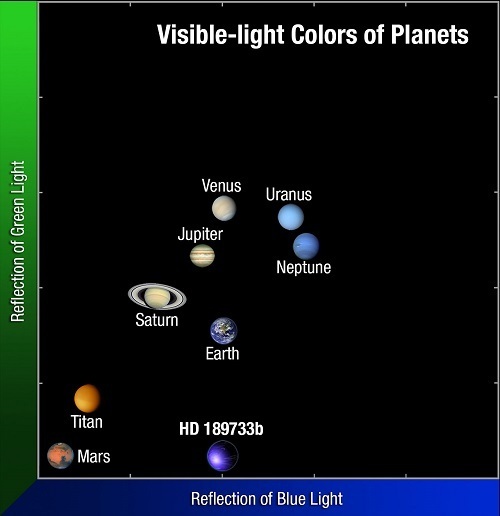
Image: This plot compares the colours of Solar System planets to the colour of the hot Jupiter HD 189733b. With the exception of Mars, the colours are primarily determined by the chemistry of the planets’ atmospheres. Earth’s blue atmosphere plus the blue tint of the oceans dominate our world’s hue. HD 189733b’s deep blue colour is produced by silicate droplets, which scatter blue light in the scorching atmosphere. Credit: NASA, ESA, and A. Feild (STScI/AURA).
The paper calls the color “…a deep, dark blue, quite distinct from the atmosphere colors seen in our solar system.” The blue may well be the result of silicate particles in the atmosphere, which scatter blue light. It’s also consistent with Pont and team’s earlier work on HD 189733b, which revealed the presence of high haze in the atmosphere and suggested red ‘sunset’ colors as the hue of HD 189733b’s sky. Sodium has previously been identified in the atmosphere and, because sodium absorbs red light and dust scatters red, this is an atmosphere that, according to this ESO news release, will redden light shining through it but turn reflected light blue.
As conducted by the Space Telescope Imaging Spectrograph, secondary eclipse observations are obviously a powerful tool. And in this case, HD 189733b once again proves a reliable touchstone on what can be accomplished to analyze the atmospheres of planets we cannot actually image. The paper is Evans et al., “The Deep Blue Color of HD189733b: Albedo Measurements with Hubble Space Telescope/Space Telescope Imaging Spectrograph at Visible Wavelengths,” Astrophysical Journal Letters Vol. 772, No. 2 (2013), L16 (abstract / preprint).






July 11, 2013
Perspectives on Pluto and Charon
We’re just past the 35th anniversary of the discovery of Pluto’s moon Charon. Or more precisely, we just passed the July 7 date when the announcement of that discovery, which had actually happened in June of 1978, was made. That turned my thoughts back to Larry Niven’s story “Wait It Out,” which tells the tale of two astronauts who are stranded on Pluto’s surface. Removing his helmet to die quickly, the narrator discovers that he lives on in a strange semi-stasis, his brain now a superconductor. First published in 1968 (in All the Myriad Ways), the story contains no Charon, but the scene lingers with me. I’ll quote just a patch of it, though I’ve quoted it before:
A superconductor is what I am. Sunlight raises the temperature too high, switching me off like a damned machine at every dawn. But at night my nervous system becomes a superconductor. Currents flow; thoughts flow; sensations flow. Sluggishly. The one hundred and fifty-three hours of Pluto’s rotation flash by in what feels like fifteen minutes. At that rate I can wait it out.
All of that, coupled with the Charon anniversary, had me thinking about what Pluto’s surface would look like with the moon included. A couple of things come to mind here. Pluto’s axial tilt (obliquity) is 124 degrees, which means that Pluto’s rotational axis is nearly in the plane of its orbit. Charon orbits the dwarf planet in its equatorial plane. Recall too that the length of Pluto’s day is the same as the orbital period of Charon. The result: Charon always presents the same face toward Pluto and vice versa.
That may seem similar to our own Moon, but because Charon orbits over Pluto’s equator, it does not appear to move relative to the horizon. This Southwest Research Institute page on the Phases of Charon, written by Marc Buie, gives further background, but the point is that because Charon orbits Pluto in the same way that communications satellites orbit the Earth, there is never a moonrise from Pluto’s surface. Moreover, the moon is invisible over half the planet.
We wind up with a moon that undergoes regular phases. If the Sun were directly over Pluto’s equator at the start of Plutonian spring, then Charon at its ‘new moon’ phase would move directly in front of the Sun, to produce an eclipse. As it moves through the rest of its 6.4 day orbit, it would progress through a series of phases. The diagram below tells the story:

Image: The Sun crossed the equator in 1988 during the middle of a 6 year season of eclipses that would have been spectacular to watch. This marked the start of spring in the northern hemisphere and the full moon was really full. Credit: SwRI/Marc W. Buie.
But take a look at the start of summer in the Northern hemisphere (this will next happen in 2030). Here the Sun passes over 56 degrees north latitude, roughly where Scotland is on Earth:

And as Buie goes on to explain:
Another longer term cycle also affects the phases and that is Pluto’s orbit around the sun. Since Pluto’s rotation axis is tipped on its side, it has very pronounced seasons. Unlike our Moon, Charon also undergoes the same exact seasons. The only time you’d see a completely full moon would be at the start of spring or fall. At the start of summer or winter, just over half the surface would be illuminated at its fullest, either the north or south polar regions depending on the season.
Charon orbits some 19,000 kilometers away from Pluto. From its surface, Pluto is gigantic in the sky, more than 14 times as wide and with 200 times the area of our Moon in the sky, as Alan Stern notes in his latest PI’s Perspective for the New Horizons mission. We can thank James Christy and Robert Harrington (U.S. Naval Observatory) for the discovery of the largest moon relative to its planet in the Solar System. And we can thank New Horizons for the image below, showing Pluto and Charon as seen from the spacecraft. New Horizons was 550 million miles from Pluto, further than the distance between the Earth and Jupiter, when the photo was taken on July 1, giving us a bit of a gut-check on the distances just to our own outer system.
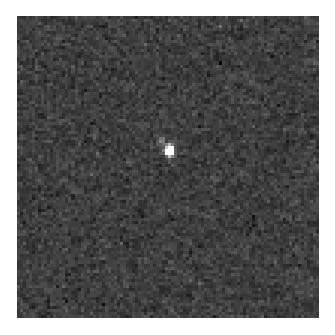
Two years from now, New Horizons will pass just over 12,000 kilometers above Pluto’s surface, where the LORRI imager will be able to spot features about the size of a football field. This is going to be a fascinating system to untangle. Charon’s interior is thought to be a combination of rock and water ice at about 50/50 proportions, while Pluto is far more rocky. The discovery of the largest moon began the study of this system as a double planet, one that is doubtless the result of a collision somewhat similar to what occurred in Earth’s early history to form our Moon. We can only imagine how much more we’ll learn as New Horizons closes the distance to its target.
Image: New Horizons LOng Range Reconnaissance Imager (LORRI) composite image showing the detection of Pluto’s largest moon, Charon, cleanly separated from Pluto itself. The frame is an average of six different LORRI images, each taken with an exposure time of 0.1 second. No other Pluto system objects are seen in the image. Credit: NASA/Johns Hopkins University Applied Physics Laboratory/Southwest Research Institute.






July 10, 2013
Prophecy, Prediction and Starflight
I’m looking forward to the upcoming Starship Congress hosted by Icarus Interstellar, which will take place in Dallas from August 15th to the 18th at the Hilton Anatole. With an audience of physicists, engineers and researchers of all kinds, this is a chance to catch up with old friends and firm up relationships that have in some cases been pursued solely through email. 2013 may be remembered as the year of the conference in interstellar terms, since we had the Tennessee Valley Interstellar Workshop in February, Starship Century in May, Starship Congress coming up in August, then the 100 Year Starship Symposium in Houston from September 19th to the 22nd.

This doesn’t include smaller events like the British Interplanetary Society’s excellent Philosophy of the Starship gathering in late May, and if you’re in range of BIS headquarters in London, it’s worth checking out what’s coming up on their always active schedule. But thoughts of indefatigable activity on the interstellar front always bring me around to Richard Obousy, president of Icarus Interstellar, who appears in a short piece titled Incredible Technology: How to Make Interstellar Spaceflight a Reality, along with Tau Zero Founder Marc Millis. Obousy is, in the best sense, an interstellar optimist.
Image: Richard Obousy, a tireless interstellar advocate now preparing for Starship Congress.
It was in Huntsville for the Tennessee Valley event that I heard Obousy use a phrase he repeated for Space.com’s Mike Wall: “I think a lot of people tend to overestimate what we can accomplish in the short term, in the next five to 10 years. But they also vastly underestimate what we can accomplish in the long term, decades or a century from now.” And that’s right on the money, because when we look ahead just a few years, we often see trends we think will accelerate, but over the long-term it’s often the factors we hadn’t yet considered that make all the difference.
I catch the same optimism in Marc Millis, who as former head of NASA’s Breakthrough Propulsion Physics project knows what it is like to be cut off at the knees by funding problems. Millis thinks the discovery of an Earth-like planet around another star will be a motivator for public engagement with space, resulting in the kind of interest that could spur demand for new exoplanet observatories and, we can hope, funding to support progress in propulsion. Advances in computer technology and the growth of commercial spaceflight, particularly through asteroid mining ventures that will extract resources and return them to Earth, should also help.
Obousy’s observation about underestimating what can happen over the long haul gibes with what David Deutsch argues in The Beginning of Infinity (Viking, 2011). Deutsch distinguishes between ‘prophecy’ and ‘prediction’ when talking about the future, prophecy being the discussion of things that are simply not knowable, whereas prediction involves conclusions that are based on good explanations. When we try to know the unknowable, we create a bias toward pessimism because we cannot know the shape or reach of future knowledge.
The growth of knowledge cannot change that fact. On the contrary, it contributes strongly to it: the ability of scientific theories to predict the future depends on the reach of their explanations, but no explanation has enough reach to predict the content of its own successors – or their effects, or those of other ideas that have not yet been thought of. Just as no one in 1900 could have foreseen the consequences of innovations made during the twentieth century – including whole new fields such as nuclear physics, computer science and biotechnology – so our own future will be shaped by knowledge that we do not yet have. We cannot even predict most of the problems that we shall encounter, or most of the opportunities to solve them, let alone the solutions and attempted solutions and how they will affect events. People in 1900 did not consider the Internet or nuclear power unlikely: they did not conceive of them at all.
Thus it may well be that the solutions we find in 2100 to problems that plague us today will come from directions we have yet to imagine. And I think the Icarus organizers are doing the smart thing by arranging their Starship Congress around time tracks: What can be done in the short-term to accelerate the progress of deep space research? What will be needed 20 to 50 years from now to achieve interstellar goals? And what can we say about longer timescales?
The interface between prediction and prophecy is a challenging place, demanding shrewd analysis and a mind open to possibility. Understanding how short-term prediction can turn into long-term prophecy reminds us of how easy it is to make blanket statements that are invalidated as new knowledge becomes available. Think of Albert Michelson’s address at the University of Chicago in 1894, when he argued that “The more important fundamental laws and facts of physical science have all been discovered, and these are now so firmly established that the possibility of their ever being supplanted in consequence of new discoveries is exceedingly remote… Our future discoveries must be looked for in the sixth place of decimals.”
Thus the view from 1894, with quantum theory and relativity looming in the near future. Deutsch would say that the physics of that year was not able to predict the content of its successors, that in fact it was not capable even of imagining the kind of changes quantum theory and relativity would bring. Comments like Michelson’s should keep us humble as we look ahead.

Millis makes much the same point in Mike Wall’s article. He’s been describing the kind of technologies under investigation for advanced propulsion, which include nuclear fusion, solar and beamed-energy sails, antimatter engines and interstellar ramjets. But as he tells Wall, none of these alternatives other than solar sails are even close to being flight-ready. Even the sails we’ve launched are experimental and far smaller than what would be needed for interstellar flight, nor have we any experience in accelerating actual sails in space through beamed energy.
But we want to move forward, and Millis thus advocates “a reasonable portfolio, a small amount spread over everything from the seemingly simple solar sails to the seemingly impossible faster-than-light [engines], and the things in between.” The goal should be to move forward through a series of achievable milestones to build momentum and attract funding. Or as Lao Tzu once put it, “You accomplish the great task by a series of small steps.”
Image: Interstellar researcher and Tau Zero founder Marc Millis.
We don’t know which propulsion option will be the one to take us to the stars, but as Deutsch would remind us, we don’t even know whether the one that actually succeeds is on our current list, because we may not have conceived of it yet. Something the philosopher Karl Popper once said sticks with me. This is from his The Myth of the Framework (Routledge, 1996):
The possibilities that lie in the future are infinite. When I say ‘It is our duty to remain optimists,’ this includes not only the openness of the future but also that which all of us contribute to it by everything we do: we are all responsible for what the future holds in store. Thus it is our duty, not to prophesy evil but, rather, to fight for a better world.






Paul Gilster's Blog
- Paul Gilster's profile
- 7 followers



